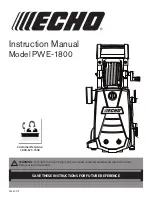
2-8
9.
Turn on the water faucets and check for
leaks. A small amount of water might enter
the washer. You will drain this later.
NOTE:
Replace inlet hoses after 5 years of use
to reduce the risk of hose failure. Record the
hose installation or replacement dates for fu-
ture reference.
• If you connect only one water hose, you must
cap off the remaining water inlet port.
• Periodically inspect and replace the hoses if
bulges, kinks, cuts, wear, or leaks are found.
SECURE DRAIN HOSE
1.
Drape the power cord over the console.
2.
Move the washer to its final location and
remove any cardboard used to move
washer.
3.
Locate the beaded tie strap (supplied).
Beaded Tie Strap
4.
Wrap the drain hose to the laundry tub leg
or standpipe with the tie strap (see illustra-
tions A and B).
If the washer faucets and the drain
standpipe are recessed, place the hooked
end of the drain hose in the standpipe (see
illustration C). Tightly wrap the tie strap
around the water inlet hoses and the drain
hose.
Do not force excess drain hose back into the
rear of the washer.
B C
A
LEVEL THE WASHER
Properly leveling the washer will help prevent
excessive noise and vibration. To level the
washer:
1.
Move the washer to its final location.
2.
Check to see if the washer is level. Check
from side-to-side and from front-to-back
by lining up the level with the top edge of
the washer cabinet where it meets the
washer top.
3.
If the washer is not level, prop up the front
of the washer with the wood block and
adjust the feet up or down as necessary. If
the washer is against a wall, move the
washer out slightly before tipping back.
Repeat this step until washer is level.
















































